Concentrations, Distribution, and Ecological Risk Assessment of Heavy Metals in Daya Bay, China
Abstract
:1. Introduction
2. Materials and Methods
2.1. Study Sites
2.2. Sample Collection and Analysis
2.3. Assessment of Ecological Risks and Contamination
2.4. Geoaccumulation Index
2.5. Statistical Analysis
3. Results and Discussion
3.1. Mean Concentrations and Comparisons
3.2. Ecological Risk Assessment
3.3. Sources Identification
4. Conclusions
Author Contributions
Acknowledgments
Conflicts of Interest
References
- Gu, Y.G.; Huang, H.H.; Lin, Q. Concentrations and human health implications of heavy metals in wild aquatic organisms captured from the core area of Daya Bay’s Fishery Resource Reserve, South China Sea. Environ. Toxicol. Pharmacol. 2016, 45, 90–94. [Google Scholar] [CrossRef] [PubMed]
- Huang, F.; Xu, Y.; Tan, Z.; Wu, Z.; Xu, H.; Shen, L.; Xu, X.; Han, Q.; Guo, H.; Hu, Z. Assessment of pollutions and identification of sources of heavy metals in sediments from west coast of Shenzhen, China. Environ. Sci. Pollut. Res. 2018, 25, 3647–3656. [Google Scholar] [CrossRef] [PubMed]
- Tuzen, M. Toxic and essential trace elemental contents in fish species from the Black Sea Turkey. Food Chem. Toxicol. 2009, 47, 1785–1790. [Google Scholar] [CrossRef] [PubMed]
- Zhang, W.; Guo, Z.; Song, D.; Du, S.; Zhang, L. Arsenic speciation in wild marine organisms and a health risk assessment in a subtropical bay of China. Sci. Total Environ. 2018, 626, 621–629. [Google Scholar] [CrossRef] [PubMed]
- Gu, Y.G.; Lin, Q.; Wang, X.H.; Du, F.Y.; Yu, Z.L.; Huang, H.H. Heavy metal concentrations in wild fishes captured from the South China Sea and associated health risks. Mar. Pollut. Bull. 2015, 96, 508–512. [Google Scholar] [CrossRef] [PubMed] [Green Version]
- Zheng, S.; Wang, P.; Wang, C.; Hou, J.; Qian, J. Distribution of metals in water and suspended particulate matter during thr resuspension processes in Taihu Lake sediment, China. Quat. Int. 2013, 286, 94–102. [Google Scholar] [CrossRef]
- Zhang, P.; Hu, R.; Zhu, L.; Wang, P.; Yin, D.; Zhang, L. Distributions and contamination assessment of heavy metals in the surface sediments of western Laizhou Bay: Implications for the sources and influencing factors. Mar. Pollut. Bull. 2017, 119, 429–438. [Google Scholar] [CrossRef] [PubMed]
- Makokha, V.A.; Qi, Y.; Shen, Y.; Wang, J. Concentrations, Distribution, and Ecological Risk Assessment of Heavy Metals in the East Dongting and Honghu Lake, China. Expo Health 2016, 8, 31–41. [Google Scholar] [CrossRef]
- Liu, M.X.; Yang, Y.Y.; Yun, X.Y.; Zhang, M.M.; Wang, J. Distribution and ecological assessment of heavy metals in surface sediments of the East Lake, China. Ecotoxicology 2014, 23, 92–101. [Google Scholar] [CrossRef] [PubMed]
- Li, G.H.; Cao, Z.M.; Lan, D.Z.; Xu, J.; Wang, S.S.; Yin, W.H. Spatial variations in grain size distribution and selected metal contents in the Xiamen Bay, China. Environ. Geol. 2007, 52, 1559–1567. [Google Scholar] [CrossRef]
- Matthiessen, P.; Law, R.J. Contaminants and their effects on estuarine and coastal organisms in the United Kingdom in the late twentieth century. Environ. Pollut. 2002, 120, 739–757. [Google Scholar] [CrossRef]
- Hill, N.A.; Simpson, S.L.; Johnston, E.L. Beyond the bed: Effects of metal contamination on recruitment to bedded sediments and overlying substrata. Environ. Pollut. 2013, 173, 182–191. [Google Scholar] [CrossRef] [PubMed]
- Gao, X.; Zhou, F.; Chen, C.A.; Xing, Q. Trace metals in the suspended particulate matter of the Yellow River (Huanghe) estuary: Concentrations, potential mobility, contamination assessment and the fluxes into the Bohai Sea. Cont. Shelf Res. 2015, 104, 25–36. [Google Scholar] [CrossRef]
- Zhang, L.; Ye, X.; Feng, H.; Jing, Y.; Ouyang, T.; Yu, X.; Liang, R.; Gao, C.; Chen, W. Heavy metal contamination in western Xiamen Bay sediments and its vicinity, China. Mar. Pollut. Bull. 2007, 54, 974–982. [Google Scholar] [CrossRef] [PubMed]
- Dou, Y.; Li, J.; Zhao, J.; Hu, B.; Yang, S. Distribution, enrichment and source of heavy metals in surface sediments of the eastern Beibu Bay, South China Sea. Mar. Pollut. Bull. 2013, 67, 137–145. [Google Scholar] [CrossRef] [PubMed]
- Vetrimurugan, E.; Shruti, V.C.; Jonathan, M.P.; Roy, P.D.; Rawlins, B.K.; Rivera-Rivera, D.M. Metals and their ecological impact on beach sediments near the marine protected sites of Sodwana Bay and St. Lucia, South Africa. Mar. Pollut. Bull. 2018, 127, 568–575. [Google Scholar] [CrossRef] [PubMed]
- Wang, Y.S.; Lou, Z.P.; Sun, C.C.; Sun, S. Ecological environment changes in Daya Bay, China, from 1982 to 2004. Mar. Pollut. Bull. 2008, 56, 1871–1879. [Google Scholar] [CrossRef] [PubMed] [Green Version]
- Wang, X.H.; Du, F.Y.; Qiu, Y.S.; Li, C.H.; Sun, D.R.; Jia, X.P. Variations of fish species diversity, faunal assemblage, and abundances in Daya Bay in 1980–2007. Chin. J. Appl. Ecol. 2010, 21, 2403–2410. (In Chinese) [Google Scholar]
- Wu, M.L.; Wang, Y.S.; Sun, C.C.; Wang, H.L.; Dong, J.D.; Han, S.H. Identification of anthropogenic effects and seasonality on water quality in Daya Bay, South China Sea. J. Environ. Manag. 2009, 90, 3082–3090. [Google Scholar] [CrossRef] [PubMed] [Green Version]
- Qiu, Y.; Wang, Z. An assessment of potential ecological risk of heavy metals in culture water area of Daya Bay. Trophic Oceanogr. 1997, 19, 49–53. [Google Scholar]
- Du, J.; Mu, H.; Song, H.; Yan, S.; Gu, Y.; Zhang, J. 100 years of sediment history of heavy metals in Daya Bay, China. Water Air Soil Pollut. 2008, 190, 343–351. [Google Scholar] [CrossRef]
- Gao, X.; Chen, S.; Long, A. Composition and sources of organic matter and its solvent extractable components in surface sediments of a bay under serious anthropogenic influences: Daya Bay, China. Mar. Pollut. Bull. 2008, 56, 1066–1075. [Google Scholar] [CrossRef] [PubMed] [Green Version]
- Yu, X.J.; Yan, Y.; Wang, W.X. The distribution and speciation of trace metals in surface sediments from the Pearl River Estuary and the Daya Bay, Southern China. Mar. Pollut. Bull. 2010, 60, 1364–1371. [Google Scholar] [CrossRef] [PubMed] [Green Version]
- Yang, J.; Cao, L.L.; Wang, J.H.; Liu, C.L.; Huang, C.G.; Cai, W.X.; Fang, H.D.; Peng, X.J. Speciation of Metals and Assessment of Contamination in Surface Sediments from Daya Bay, South China Sea. Sustainability 2014, 6, 9096–9113. [Google Scholar] [CrossRef] [Green Version]
- Bai, J.; Jia, J.; Zhang, G.; Zhao, Q.; Lu, Q.; Cui, B.; Liu, X. Spatial and temporal dynamics of heavy metal pollution and source identification in sediment cores from the short-term flooding riparian wetlands in a Chinese delta. Environ. Pollut. 2016, 219, 379–388. [Google Scholar] [CrossRef] [PubMed]
- Wen, X.; Wang, Q.; Zhang, G.; Bai, J.; Wang, W.; Zhang, S. Assessment of heavy metals contamination in soil profiles of roadside Suaeda salsa wetlands in the Yellow River Delta, China. Phys. Chem. Earth Parts A/B/C 2017, 97, 71–76. [Google Scholar] [CrossRef]
- Wang, Y.S.; Lou, Z.P.; Sun, C.C.; Wu, M.L.; Han, S.H. Multivariate statistical analysis of water quality and phytoplankton characteristics in Daya Bay, China, from 1999 to 2002. Oeanologia 2006, 48, 193–211. [Google Scholar]
- Liu, M.X.; Yang, Y.Y.; Yun, X.Y.; Zhang, M.M.; Wang, J. Concentrations, distribution, sources, and ecological risk assessment of heavy metals in agricultural topsoil of the Three Gorges Dam region, China. Environ. Monit. Assess. 2005, 187, 147–153. [Google Scholar] [CrossRef] [PubMed]
- Li, G.; Hu, B.; Bi, J.; Leng, Q.; Xiao, C.; Yang, Z. Heavy metals distribution and contamination in surface sediments of the coastal Shandong Peninsula (Yellow Sea). Mar. Pollut. Bull. 2013, 76, 420–426. [Google Scholar] [CrossRef] [PubMed]
- Hakanson, L. An ecological risk index for aquatic pollution control, a sedimentological approach. Water Res. 1980, 14, 975–1001. [Google Scholar] [CrossRef]
- Zhao, Y.; Yan, M. Geochemistry of Shallow Sea Sediment in China; Science Publisher: Beijing, China, 1994. (In Chinese) [Google Scholar]
- Müller, G. Die Schwermetallbelastung der sediments des Neckars und seiner Nebenflusse: Eine Bestandsaufnahme. Chemiker-Zeitung 1981, 5, 157–164. [Google Scholar]
- Zhou, F.; Guo, H.; Liu, L. Quantitative identification and source apportionment of anthropogenic heavy metals in marine sediment of Hong Kong. Environ. Geol. 2007, 53, 295–305. [Google Scholar] [CrossRef]
- Zhao, G.; Ye, S.; Yuan, H.; Ding, X.; Wang, J. Surface sediment properties and heavy metal pollution assessment in the Pearl River Estuary, China. Environ. Sci. Pollut. Res. 2017, 24, 2966–2979. [Google Scholar] [CrossRef] [PubMed]
- Yu, R.; Yuan, X.; Zhao, Y.; Hu, G.; Tu, X. Heavy metal pollution in intertidal sediments from Quanzhou Bay, China. J. Environ. Sci. 2008, 20, 664–669. [Google Scholar] [CrossRef]
- Qiao, Y.M.; Yang, Y.; Gu, J.G.; Zhao, J.G. Distribution and geochemical speciation of heavy metals in sediments from coastal area suffered rapid urbanization, a case study of Shantou Bay, China. Mar. Pollut. Bull. 2013, 68, 140–146. [Google Scholar] [CrossRef] [PubMed]
- Qiu, Y.W.; Yu, K.F. Accumulation of heavy metals in sediment of mangrove wetland from Hainan Island. J. Trophic Oceangr. 2011, 30, 102–108. [Google Scholar]
- Xiao, C.; Jian, H.; Chen, L.; Liu, C.; Gao, H.; Zhang, C.; Liang, S.; Li, Y. Toxic metal pollution in the Yellow Sea and Bohai Sea, China: Distribution, controlling factors and potential risk. Mar. Pollut. Bull. 2017, 119, 381–389. [Google Scholar] [CrossRef] [PubMed]
- State Environmental Protection Administration of China (SEPA). Marine Sediment Quality (GB 18668-2002); Standards Press of China: Beijing, China, 2002. (In Chinese) [Google Scholar]
- Long, E.R.; Macdonald, D.D.; Smit, S.L.; Calder, F.D. Incidence of adverse biological effects within ranges of chemical concentrations in marine and estuaryne sediments. Environ. Manag. 1995, 19, 81–97. [Google Scholar] [CrossRef]
- Chen, W.; Zhou, J.; Li, Y. Tendency and Causes Analysis of Marine Water Quality of Daya Bay. Environ. Sci. Technol. 2010, 33, 28–32. [Google Scholar]
- Nosrati-Ghods, N.; Ghadiri, M.; Fruh, W.G. Management and environmental risk study of the physicochemical parameters of ballast water. Mar. Pollut. Bull. 2017, 114, 428–438. [Google Scholar] [CrossRef] [PubMed]
- Feng, D.L.; Chen, X.F.; Tian, W.; Qian, Q.; Shen, H.; Liao, D.X.; Lv, B.Y. Pollution characteristics and ecological risk of heavy metals in ballast tank sediment. Environ. Sci. Pollut. Res. 2017, 24, 3951–3958. [Google Scholar] [CrossRef] [PubMed]
- Jian, Z. Study on Organic Pollutants Sources and their Distribution Characteristics in Daya Bay Waters. Master’s Thesis, Ocean University of China, Qingdao, China, 2005. (In Chinese). [Google Scholar]
- Duc, T.A.; Loi, V.D.; Thao, T.T. Partition of heavy metals in a tropical river system impacted by municipal waste. Environ. Monit. Assess. 2013, 185, 1907–1925. [Google Scholar] [CrossRef] [PubMed]
- Laing, G.D.; Vos, R.D.; Vandecasteele, B.; Lesage, E.; Tack, F.M.G.; Verloo, M.G. Effect of salinity on heavy metal mobility and availability in intertidal sediments of the Scheldt estuary. Estuar. Coast. Shelf Sci. 2008, 77, 589–602. [Google Scholar] [CrossRef]
- Popenda, A. Effect of redox potential on heavy metals and as behavior in dredged sediments. Desalination Water Treat. 2014, 52, 3918–3927. [Google Scholar] [CrossRef]
- Kelderman, P.; Osman, A.A. Effect of redox potential on heavy metal binding forms in polluted canal sediments in Delft (The Netherlands). Water Res. 2007, 41, 4251–4261. [Google Scholar] [CrossRef] [PubMed]
- Xiao, R.; Bai, J.; Huang, L.; Zhang, H.; Cui, B.; Liu, X. Distribution and pollution, toxicity and risk assessment of heavy metals in sediments from urban and rural rivers of the Pearl River delta in southern China. Ecotoxicology 2013, 22, 1564–1575. [Google Scholar] [CrossRef] [PubMed]
- Marcin, S.; Mariusz, S. Application of multivariate statistical approach to identifytrace elements sources in surface waters: A case study of Kowalskie and Stare Miasto reservoirs, Poland. Environ. Monit. Assess. 2017, 189, 364. [Google Scholar]
- Emerson, S.; Hedges, J.I. Processes controlling the organic carbon content of open ocean sediments. Paleoceanography 1998, 3, 621–634. [Google Scholar] [CrossRef]
- Gao, X.; Yang, Y.; Wang, C. Geochemistry of organic carbon and nitrogen in surface sediments of coastal Bohai Bay inferred from their ratios and stable isotopic signatures. Mar. Pollut. Bull. 2012, 64, 1148–1155. [Google Scholar] [CrossRef] [PubMed] [Green Version]
- Ke, Z.; Tan, Y.; Huang, L.; Zhao, C.; Jiang, X. Spatial distributions of δ13C, δ15N and C/N ratios in suspended particulate organic matter of a bay under serious anthropogenic influences: Daya Bay, China. Mar. Pollut. Bull. 2017, 114, 183–191. [Google Scholar] [CrossRef] [PubMed]

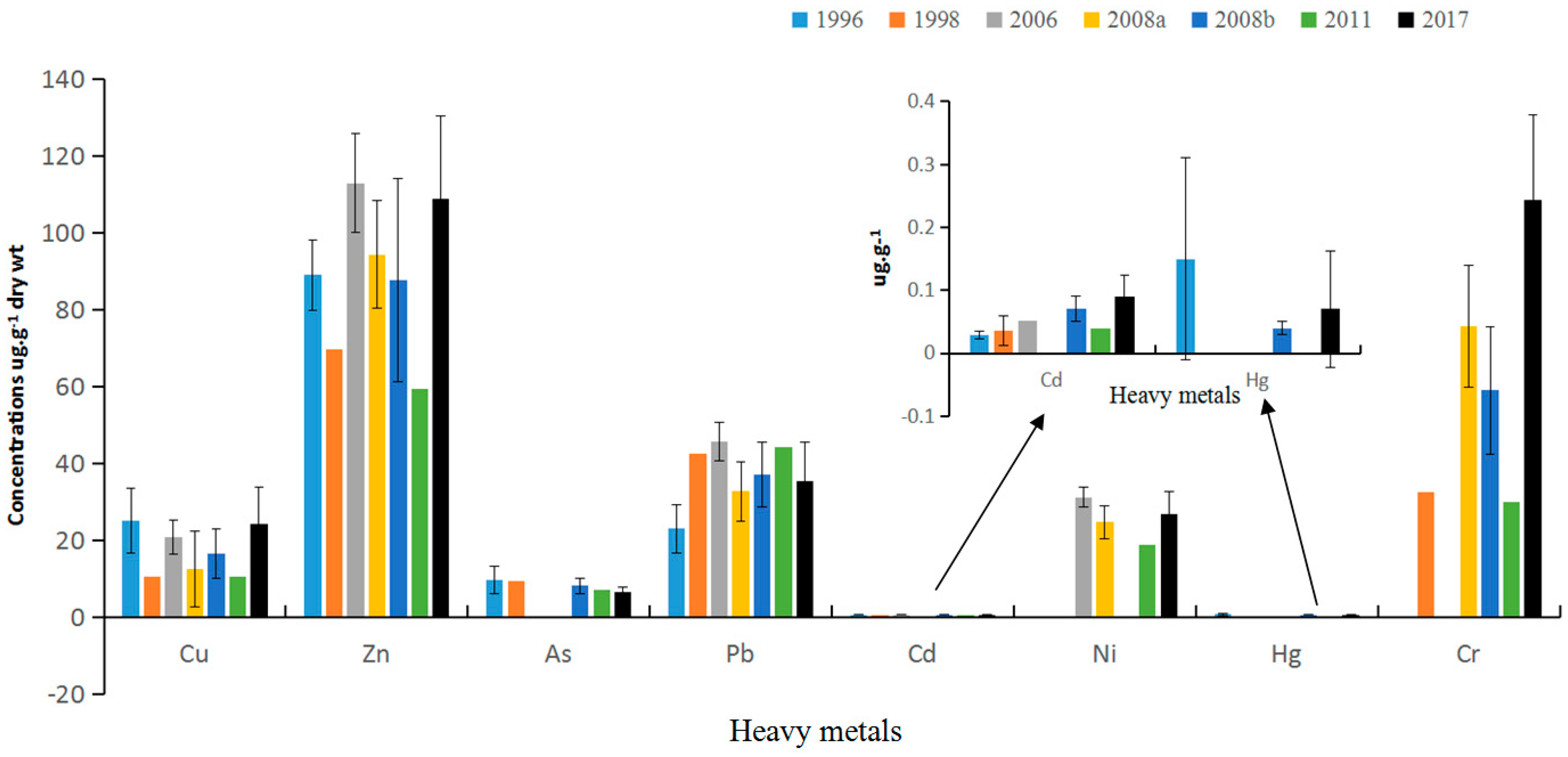
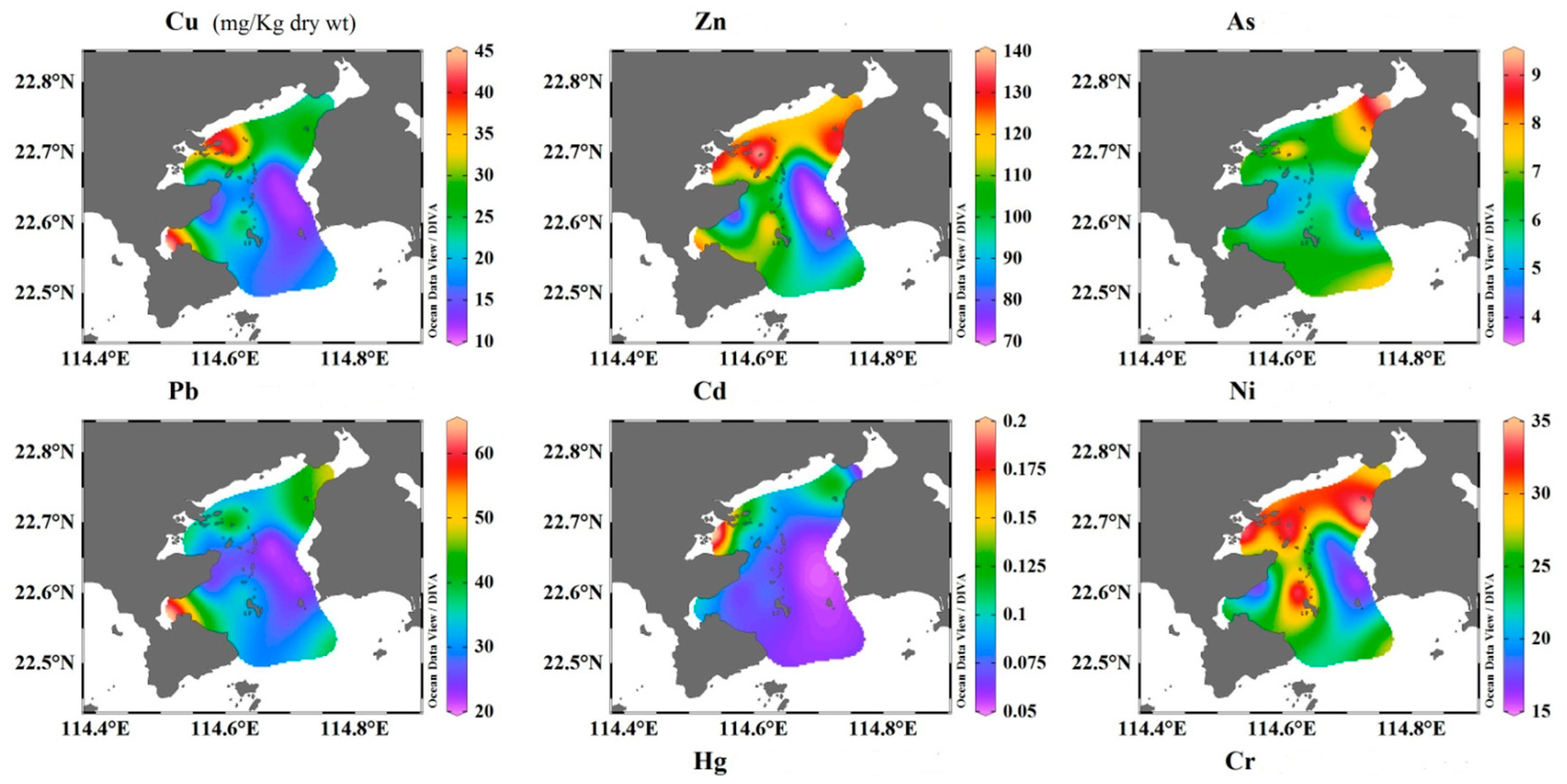
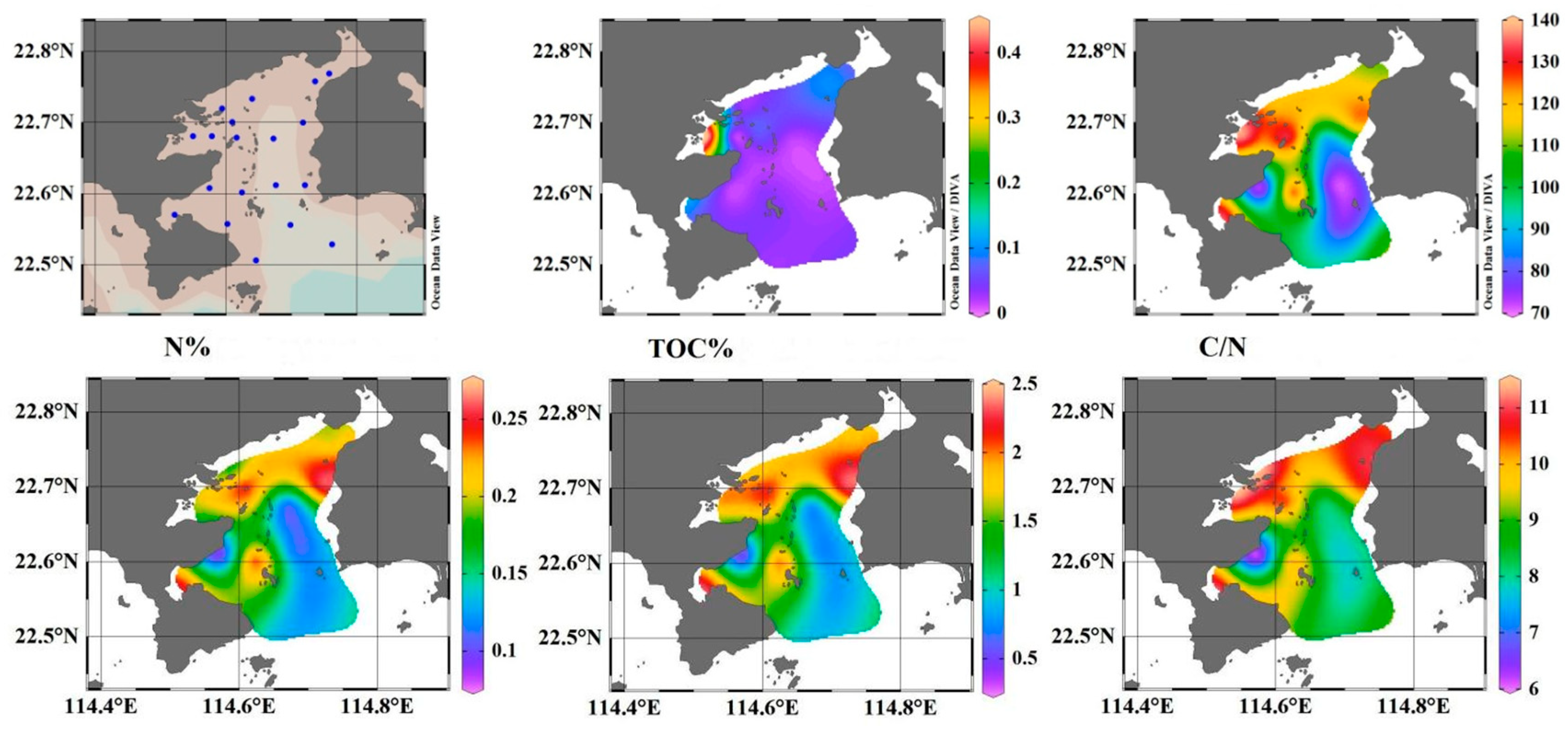
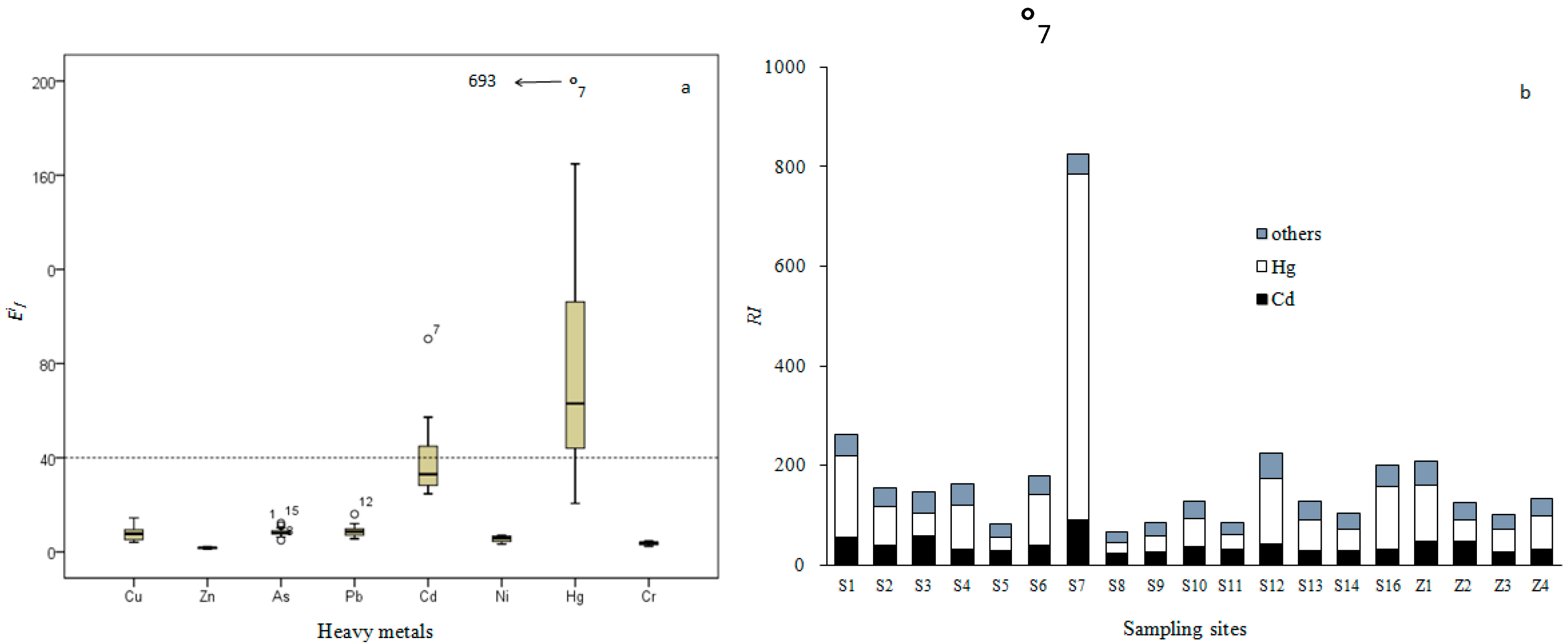
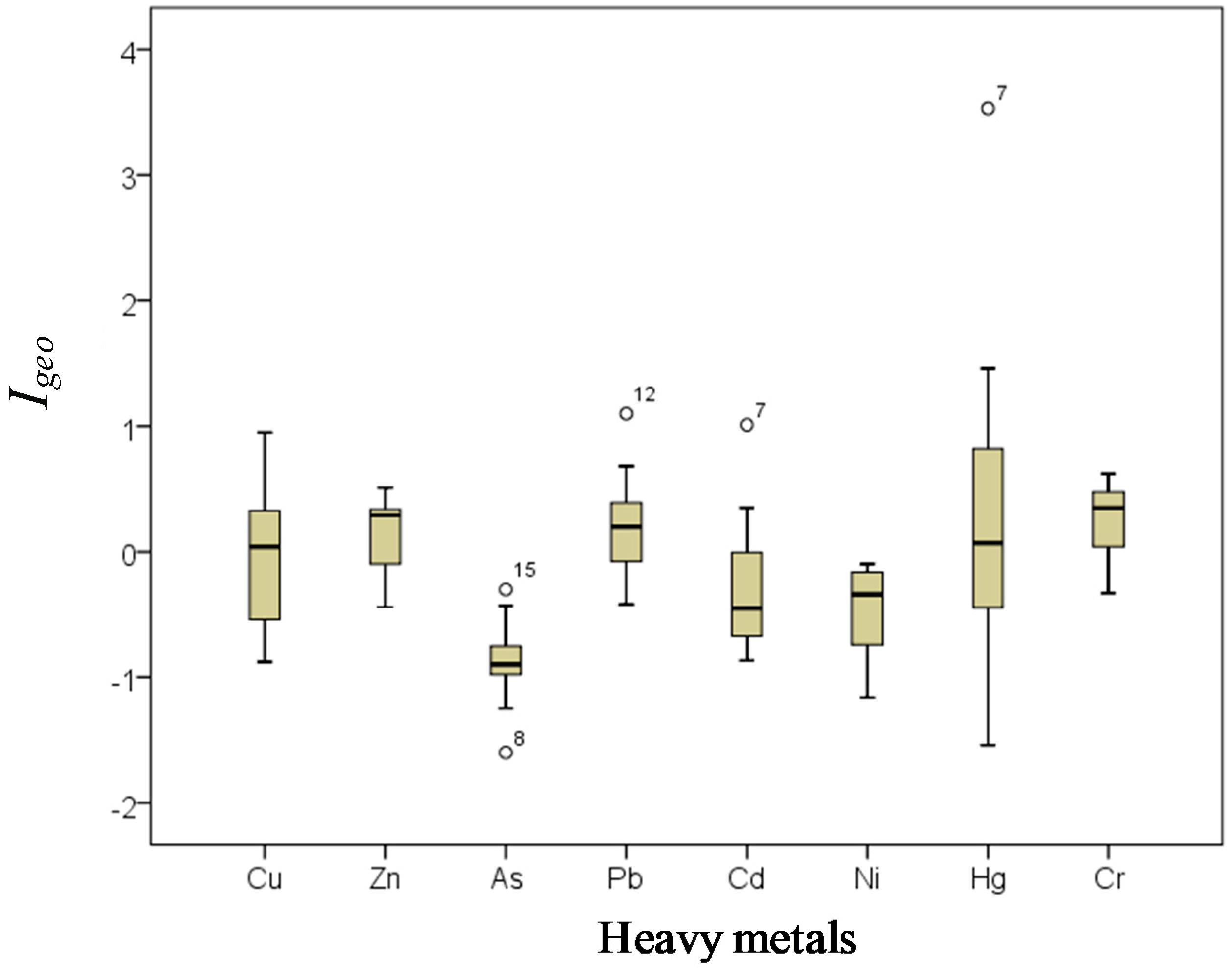
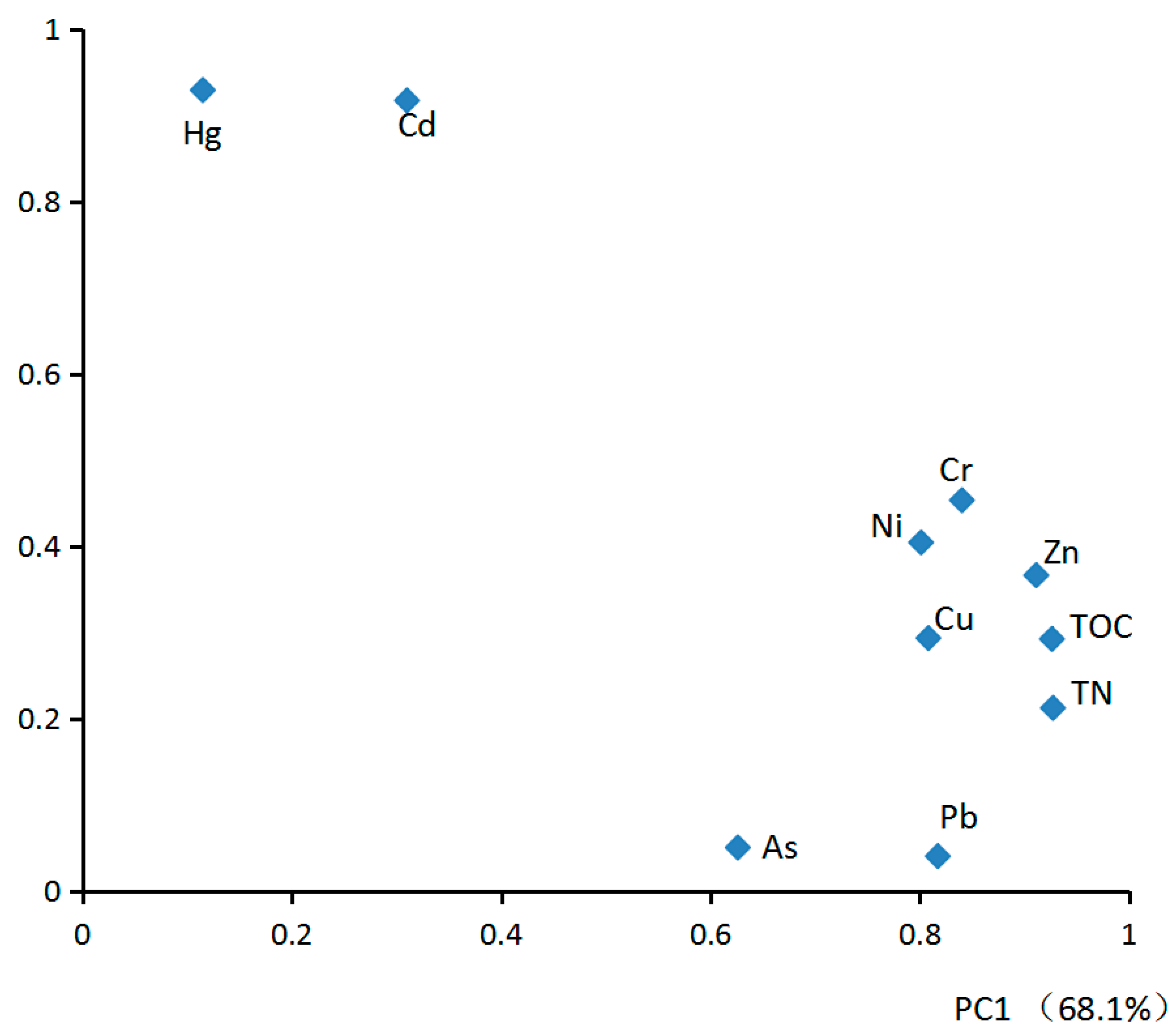
| Standard | Location | Concentration (µg g−1 dry wt) | ||||||||
|---|---|---|---|---|---|---|---|---|---|---|
| Cu | Zn | As | Pb | Cd | Ni | Hg | Cr | Reference | ||
| Daya Bay, China, mean (SD) | 24.1 (9.7) | 108.9 (21.5) | 6.5 (1.3) | 35.3 (10.1) | 0.09 (0.03) | 26.8 (6.0) | 0.07 (0.1) | 108.7 (21.9) | This study | |
| Daya Bay, China, range | 12.2–43.4 | 71.8–138.5 | 3.8–9.4 | 22.5–64.2 | 0.05–0.2 | 16.1–33.6 | 0.01–0.43 | 71.3–138.0 | ||
| Pearl River Estuary, China | 46.8 | 143.1 | 22 | 50 | 0.46 | NA a | 0.13 | 78.4 | [34] | |
| Shantou Bay, China | 48.5 | 153.3 | 51.6 | 0.67 | 22.95 | NA | 53.6 | [36] | ||
| Quanzhou Bay, China | 71.4 | 179.6 | 21.7 | 67.7 | 0.69 | NA | NA | 82 | [35] | |
| Sanya Bay, China | 9.5 | 53.1 | 7.1 | 17.5 | 0.13 | NA | NA | 12.4 | [37] | |
| Weste Laizhou Bay, China | 6.89 | NA | 4.84 | 14.01 | 0.08 | NA | NA | 17.1 | [7] | |
| Yellow Sea, China | 19.8 | 67.1 | 7.2 | 16.3 | 0.26 | 25.7 | 0.2 | 45.4 | [38] | |
| Beibu Bay, China | 58.3 | 67.3 | 9.53 | 28 | 0.16 | NA | 0.06 | 53.6 | [15] | |
| Background in Daya Bay | 15 | 65 | 7.7 | 20 | 0.065 | 24 | 0.025 | 60 | [31] | |
| GB 18668-2002 | Class I b | 35 | 150 | 20 | 60 | 0.5 | 0.2 | 80 | [39] | |
| Class I b | 100 | 350 | 65 | 130 | 1.5 | 0.5 | 150 | |||
| Class III b | 200 | 600 | 93 | 250 | 5 | 1 | 270 | |||
| Effects-based SQGs | ERL c | 34 | 150 | 8.2 | 47 | 1.2 | 21 | 0.15 | 81 | [40] |
| ERM c | 270 | 410 | 70 | 218 | 9.6 | 52 | 0.71 | 370 | ||
| Items | Salinity | Eh | TOC % | TN % | Cu | Zn | As | Pb | Cd | Ni | Hg | Cr |
|---|---|---|---|---|---|---|---|---|---|---|---|---|
| Salinity | 1 | |||||||||||
| Eh | −0.35 | 1 | ||||||||||
| TOC % | −0.72 ** | −0.55 ** | 1 | |||||||||
| TN % | −0.67 ** | −0.57 ** | 0.99 ** | 1 | ||||||||
| Cu | −0.64 ** | −0.47 * | 0.81 ** | 0.77 ** | 1 | |||||||
| Zn | −0.69 ** | −0.61 ** | 0.95 ** | 0.93 ** | 0.82 ** | 1 | ||||||
| As | −0.49 * | −0.16 | 0.48 * | 0.44 | 0.36 | 0.58 ** | 1 | |||||
| Pb | −0.56 ** | −0.26 | 0.71 ** | 0.69 ** | 0.73 ** | 0.68 ** | 0.65 ** | 1 | ||||
| Cd | −0.55 ** | −0.77 ** | 0.54 ** | 0.45 | 0.58 ** | 0.61 ** | 0.25 | 0.316 | 1 | |||
| Ni | −0.58 ** | −0.66 ** | 0.88 ** | 0.86 ** | 0.67 ** | 0.931 ** | 0.50 * | 0.46 * | 0.58 ** | 1 | ||
| Hg | −0.41 | −0.72 ** | 0.35 | 0.28 | 0.30 | 0.42 | 0.27 | 0.27 | 0.84 ** | 0.40 | 1 | |
| Cr | −0.65 ** | −0.62 ** | 0.93 ** | 0.9 ** | 0.80 ** | 0.94 ** | 0.42 | 0.63 ** | 0.66 ** | 0.89 ** | 0.47 * | 1 |
© 2018 by the authors. Licensee MDPI, Basel, Switzerland. This article is an open access article distributed under the terms and conditions of the Creative Commons Attribution (CC BY) license (http://creativecommons.org/licenses/by/4.0/).
Share and Cite
Tang, H.; Ke, Z.; Yan, M.; Wang, W.; Nie, H.; Li, B.; Zhang, J.; Xu, X.; Wang, J. Concentrations, Distribution, and Ecological Risk Assessment of Heavy Metals in Daya Bay, China. Water 2018, 10, 780. https://doi.org/10.3390/w10060780
Tang H, Ke Z, Yan M, Wang W, Nie H, Li B, Zhang J, Xu X, Wang J. Concentrations, Distribution, and Ecological Risk Assessment of Heavy Metals in Daya Bay, China. Water. 2018; 10(6):780. https://doi.org/10.3390/w10060780
Chicago/Turabian StyleTang, Huijuan, Zhixin Ke, Muting Yan, Wenjing Wang, Huayue Nie, Boxing Li, Jingping Zhang, Xiangrong Xu, and Jun Wang. 2018. "Concentrations, Distribution, and Ecological Risk Assessment of Heavy Metals in Daya Bay, China" Water 10, no. 6: 780. https://doi.org/10.3390/w10060780





